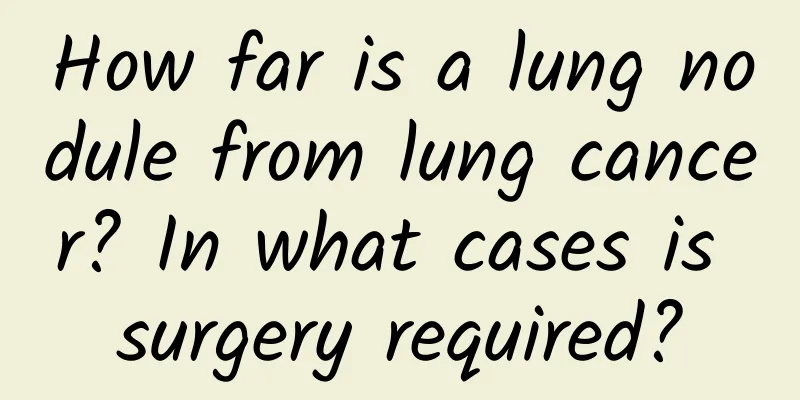How far is a lung nodule from lung cancer? In what cases is surgery required?

|
As people's health awareness increases, more and more people are diagnosed with small lung nodules. People take CT reports to check online and offline, hoping to remove the nodules, but they are afraid of surgery. The anxious mentality not only affects their normal life and work, but also brings great trouble to their families. Lung nodules have become a "heart knot". How far is a lung nodule from lung cancer? Which lung nodules can be observed? Which ones require surgery? Most of them are benign, so there is no need to worry too much Pulmonary nodules refer to soft tissue lesions in the lung parenchyma that are round, have clear boundaries, and are less than or equal to 3 cm in diameter. Clinically, lesions larger than 3 cm are called masses, those less than or equal to 3 cm are called nodules, and nodules less than 1 cm are mostly called small nodules. The size of the nodules is somewhat correlated with whether they are benign or malignant. Lesions larger than 3 cm are mostly malignant, while smaller ones are mostly benign. It has been reported that more than 90% of small lung nodules found through chest CT scans for the first time during health checkups or lung cancer screening programs are benign. However, we should not take it lightly. Peripheral lung cancer, which has the highest incidence rate among malignant lung cancers, often manifests as small lung nodules or ground-glass opacities in the early stages. According to the density of lung nodules, lung nodules can be divided into solid lung nodules, pure ground glass nodules, and mixed ground glass nodules. 1. Mixed ground glass nodules can be compared to "fried eggs", with a solid center. They are most likely to be malignant and require high vigilance; 2. Pure ground glass nodules are like "egg white" with no obvious solid components. Their malignancy rate is second only to that of "fried eggs". Although they have the highest detection rate in clinical practice, they may just be common inflammation or fungal infection. 3. Purely solid nodules can be compared to "boiled eggs", which are solid throughout. Small "boiled eggs" have the lowest chance of malignancy, but larger "boiled eggs" require high attention, as they are relatively more malignant and require surgical removal as soon as possible. Regular review is important When a lung nodule is discovered, how to deal with it is a problem that many people must face. The "Guidelines for the Classification, Diagnosis and Treatment of Lung Nodules in China" compiled by the Chinese Lung Cancer Early Diagnosis and Treatment Expert Group combines the latest lung nodule treatment guidelines at home and abroad and the practice of clinical and population screening in my country. It is recommended to take the size of lung nodules as an example: 1. If the diameter is less than 5 mm and there is no history of tumor or family history, the possibility of malignancy is low, about less than 1%, and CT scans can be performed every 6 to 12 months; 2. When the diameter is 5-10 mm, the possibility of malignancy is 6%-28%, and it should be reviewed every 3 months; 3. Lung nodules with a diameter greater than 10 mm should be reviewed every 1 to 2 months. If the above-mentioned small nodules are found to have no changes during follow-up, the follow-up period will be extended to 3 months, 6 months, and 1 year respectively. It should be noted that the probability of malignancy of lung nodules with a diameter greater than 20 mm reaches 80%, and they must be closely followed up and surgically removed in time if necessary. When a lung nodule has no changes for 2 years, it can be generally considered a benign nodule; if there are changes, a judgment will be made based on the changes and the next treatment opinion will be decided. If surgery is really needed, patients do not need to worry too much. Currently, most lung nodule surgeries can be treated with minimally invasive thoracoscopic surgery, which only requires 1 to 2 1 to 3 cm incisions on the chest wall. The operation time is short and the recovery is fast. Most patients can be discharged from the hospital on the 3rd to 4th day after surgery. Stay away from high-risk factors to ensure effective prevention There are many causes of pulmonary nodules, among which smoking, car exhaust, haze, and oil smoke are all high-risk factors. Therefore, the following points should be taken to prevent pulmonary nodules: 1. In daily life, it is best to smoke less, avoid going to places with serious pollution, stay away from dust, and try to avoid contact with harmful aerosols, such as kitchen fumes, secondhand smoke, dust, coal, gas and other volatile organic compounds, and take protective measures to reduce damage to the lungs; 2. Timely and active treatment of chronic lung diseases, such as chronic bronchitis, chronic lung inflammation, tuberculosis, lung scar lesions, pneumoconiosis, etc.; 3. Maintaining good eating and living habits, exercising appropriately, and maintaining a good mood are all beneficial to lung health. |
>>: This drug can be used to prevent heart attacks, but no one believed it at first because...
Recommend
What to do if you lose hair during pregnancy
A woman's body will undergo slight changes af...
The fetal heart rate of a boy is about 140 and that of a girl is about 150
Can the gender of the fetus be determined based o...
What will happen if you don't eat during the confinement period?
The body of a mother needs some time to recover a...
What causes a lump on a woman's breast?
A lump growing on a woman's breast may be a m...
What to do if breast cysts enlarge?
Cystic breast hyperplasia is a common disease amo...
What are the symptoms of HPV?
When a woman is infected with the HPV virus, the ...
At what age do girls start to develop breasts?
At what age do girls usually start to develop bre...
What are the symptoms of pregnancy ten days after sex?
Pregnancy seems to be a very random thing, so man...
Sexual health care for menopausal women
Many people believe that women will no longer hav...
How long does it take for the uterus to return to normal after a normal birth?
After ten months of pregnancy, giving birth to a ...
Vaginal ulcers are like this
The female vaginal opening is a component of the ...
Dryness before period is a sign of pregnancy
Pregnancy is a very important stage for women. Th...
GlobalWebIndex: Google+ has 360 million active users in May 2013
On the evening of May 1, 2013, the latest report ...
How long does it take for HPV58 to be positive?
HPV58 positive indicates HPV58 infection. HPV58 i...
Is it good for women to drink soy milk during menstruation? Is it good to drink soy milk during menstruation? Can I drink soy milk during menstruation?
Many people like to drink soy milk, which can sup...









